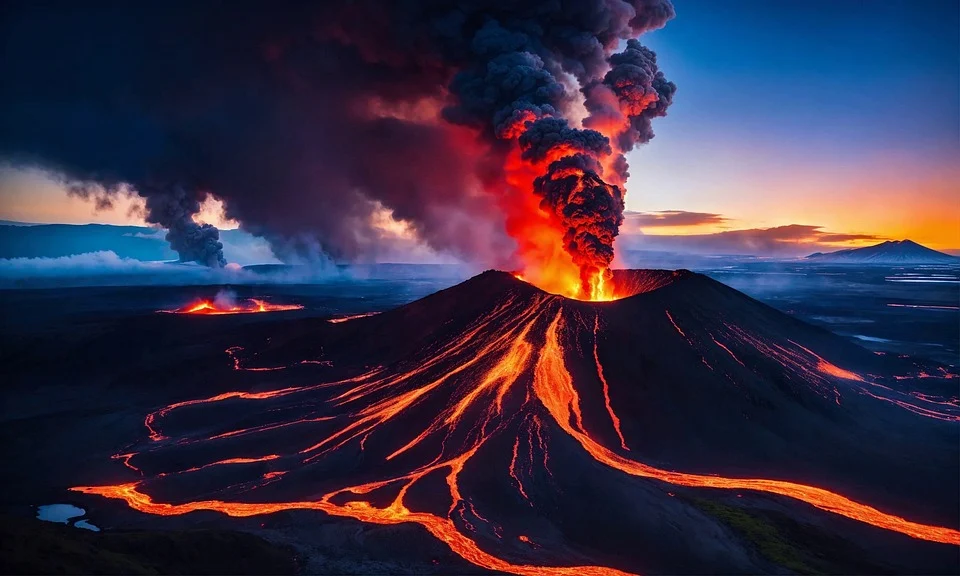Date: November 7, 2024
Location: Kamchatka Peninsula, Russia
A strong explosive eruption began at Russia’s Sheveluch volcano at 09:20 UTC on November 7, 2024, triggering significant concern due to the large ash plume that rapidly ascended to heights of 11 km (36,000 feet) above sea level. The eruption has prompted the authorities to raise the Aviation Color Code to Red, signaling the potential for serious disruption to air traffic in the region.
The eruption, one of the strongest in recent years, produced intense volcanic ash emissions, with the ash cloud drifting east-northeast from the volcano, threatening aviation routes that pass over or near the Kamchatka Peninsula. Local authorities and aviation officials have issued urgent warnings, urging airlines to avoid affected airspace as the volcanic ash poses a serious risk to aircraft.
Eruption Details and Impact on Air Traffic
Sheveluch, located on the Kamchatka Peninsula in Russia’s far east, is one of the most active volcanoes in the country. The eruption began early on November 7, and by mid-morning, the ash plume had already reached dangerous altitudes. The ash cloud has now expanded over a significant distance, drifting east-northeast, and is expected to continue to move with the prevailing wind patterns.
With the eruption’s explosive nature, the Aviation Red Alert indicates that the ash plume could reach altitudes hazardous for aircraft engines and flight navigation. The ash poses multiple threats to aviation, including engine damage, reduced visibility, and the potential for engine failure if aircraft fly through the plume.
The Russian Federal Air Transport Agency and local aviation authorities have already rerouted flights in the affected area and advised airlines to avoid the region. Flight cancellations and delays are expected as long as the eruption continues to emit ash.
Volcanic Ash and Environmental Impact
The eruption’s volcanic ash has the potential to travel hundreds of kilometers, depending on wind conditions, and may impact not only air traffic but also the environment. The ash fallout could affect local communities in the Kamchatka region, with potential disruptions to air quality, water sources, and transportation.
Sheveluch’s eruptions have been known to cause problems for aircraft operations in the region, particularly in the Pacific Ocean flight routes that pass through Kamchatka. However, the extent of the environmental and societal impacts will depend on the continuing volcanic activity and the persistence of the ash cloud.
Monitoring and Response
Russia’s Kamchatka Volcanic Eruption Response Team (KVERT) has been closely monitoring the situation, issuing regular updates on the eruption’s activity. Satellite imagery and seismic data are being used to track the plume’s movement, while scientists continue to assess the potential for further explosive events.
The Institute of Volcanology and Seismology in Petropavlovsk-Kamchatsky is also providing real-time data on the volcano’s seismic activity and gas emissions, which will help to predict whether the eruption will escalate or subside in the coming days.
Emergency protocols have been enacted in nearby communities, and authorities are on high alert in case the eruption intensifies or if pyroclastic flows or lava reach surrounding areas.
History of Sheveluch’s Volcanic Activity
Sheveluch has a long history of explosive eruptions. The volcano is known for its frequent activity and has produced some of the most powerful eruptions in Russia. In 2000, an eruption at Sheveluch released an ash plume that reached over 20,000 feet and caused significant disruption. The latest eruption, which started on November 7, appears to be one of the most substantial in recent years, and authorities are bracing for the possibility of further explosive events.
Global Implications and Ongoing Monitoring
The Aviation Red Alert for Sheveluch is a reminder of the risks posed by active volcanoes, especially in regions like Kamchatka, which are heavily traveled by international air traffic. The eruption could have broader implications for global flight paths, depending on the behavior of the ash cloud and its movement across the Northern Pacific.
In the coming hours and days, aviation officials will continue to track the movement of the ash and update flight routing and airspace advisories. Meanwhile, experts in volcanic monitoring are keeping a close watch for any signs of increased activity, including the potential for additional ash plumes, lava flows, or pyroclastic flows.
Conclusion
The Sheveluch volcano’s explosive eruption on November 7, 2024, has created immediate risks to air travel in the region and posed significant challenges for local communities. With the Aviation Color Code raised to Red, the potential for further volcanic hazards is a serious concern. As the situation develops, monitoring agencies will continue to provide updates, and air traffic authorities will adjust flight routes to ensure the safety of passengers and aircraft. Local authorities are also on high alert to protect communities from potential ash fallout and other dangers associated with this powerful eruption.
References:



